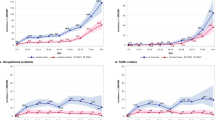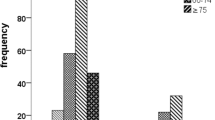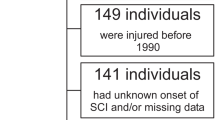Abstract
Study design
Retrospective epidemiological study.
Objectives
Since the causes and incidences of traumatic spinal cord injury (TSCI) in each country change over time, up-to-date epidemiological studies are required for countermeasures against TSCI. However, no nationwide survey in Japan has been conducted for about 30 years. The purpose of this study was therefore to investigate the recent incidence and characteristics of TSCI in Japan.
Setting
Japan
Methods
Survey sheets were sent to all hospitals (emergency and acute care hospitals) that treated TSCI persons in Japan in 2018 and case notes were retrospectively reviewed. Frankel grade E cases were excluded from analysis.
Results
The response rate was 74.4% (2804 of 3771 hospitals). The estimated annual incidence of TSCI excluding Frankel E was 49 per million, with a median age of 70.0 years and individuals in their 70s as the largest age group. Male-to-female ratio was 3:1. Cervical cord injuries occurred in 88.1%. Frankel D was the most frequent grade (46.3%), followed by Frankel C (33.0%). The most frequent cause was fall on level surface (38.6%), followed by traffic accident (20.1%). The proportion of fall on level surface increased with age. TSCI due to sports was the most frequent cause in teenagers (43.2%).
Conclusions
This nationwide survey in Japan showed that estimated incidence of TSCI, rate of cervical cord injury, and incomplete injury by falls appear to be increasing with the aging of the population.
Similar content being viewed by others
Log in or create a free account to read this content
Gain free access to this article, as well as selected content from this journal and more on nature.com
or
Data availability
The datasets used in this study are publicly available.
Change history
02 September 2020
This article has had values in Table 1 and Table 4 updated. These updates do not affect the integrity of the data, but improve the clarity of the tables.
References
Assinck P, Duncan GJ, Hilton BJ, Plemel JR, Tetzlaff W. Cell transplantation therapy for spinal cord injury. Nat Neurosci. 2017;20:637–47.
Tsuji O, Sugai K, Yamaguchi R, Tashiro S, Nagoshi N, Kohyama J, et al. Concise review: laying the groundwork for a first-in-human study of an induced pluripotent stem cell-based intervention for spinal cord injury. Stem Cells. 2019;37:6–13.
Cheung EYY, Ng TKW, Yu KKK, Kwan RLC, Cheing GLY. Robot-assisted training for people with spinal cord injury: a meta-analysis. Arch Phys Med Rehabil. 2017;98:2320–31.
Lee BB, Cripps RA, Fitzharris M, Wing PC. The global map for traumatic spinal cord injury epidemiology: update 2011, global incidence rate. Spinal Cord. 2014;52:110–6.
Jazayeri SB, Beygi S, Shokraneh F, Hagen EM, Rahimi-Movaghar V. Incidence of traumatic spinal cord injury worldwide: a systematic review. Eur Spine J. 2015;24:905–18.
Tator CH, Duncan EG, Edmonds VE, Lapczak LI, Andrews DF. Changes in epidemiology of acute spinal cord injury from 1947 to 1981. Surg Neurol. 1993;40:207–15.
Roche SJ, Sloane PA, McCabe JP. Epidemiology of spine trauma in an Irish regional trauma unit: a 4-year study. Injury. 2008;39:436–42.
Raja IA, Vohra AH, Ahmed M. Neurotrauma in Pakistan. World J Surg. 2001;25:1230–7.
Masini M. An estimation of incidence and prevalence of spinal cord injury in Brazil. J Bras Neurocir. 2001;12:97–100.
Saiki S. Population. In: Statistics Bureau Ministry of Internal Affairs and Communications Japan, editor. Statistical handbook of japan 2019. Tokyo: Statistics Bureau; 2019. pp. 10.
Shingu H, Ohama M, Ikata T, Katoh S, Akatsu T. A nationwide epidemiological survey of spinal cord injuries in Japan from January 1990 to December 1992. Paraplegia. 1995;33:183–8.
Katoh S, Enishi T, Sato N, Sairyo K. High incidence of acute traumatic spinal cord injury in a rural population in Japan in 2011 and 2012: an epidemiological study. Spinal Cord 2014;52:264–7.
Frankel HL, Hancock DO, Hyslop G, Melzak J, Michaelis LS, Ungar GH, et al. The value of postural reduction in the initial management of closed injuries of the spine with paraplegia and tetraplegia. I. Paraplegia. 1969;7:179–92.
Hashimoto S, Fukutomi K, Nagai M, Nakamura Y, Yanagawa H, Sasaki R, et al. Response bias in the nationwide epidemiological survey of an intractable disease in Japan. J Epidemiol. 1991;1:27–30.
Jain NB, Ayers GD, Peterson EN, Harris MB, Morse L, O’Connor KC, et al. Traumatic spinal cord injury in the United States, 1993-2012. JAMA. 2015;313:2236–43.
Kudo D, Miyakoshi N, Hongo M, Kasukawa Y, Ishikawa Y, Ishikawa N, et al. An epidemiological study of traumatic spinal cord injuries in the fastest aging area in Japan. Spinal Cord. 2019;57:509–15.
Katoh S, Shingu H, Ikata T, Iwatsubo E. Sports-related spinal cord injury in Japan (From the nationwide spinal cord injury registry between 1990 and 1992). Spinal Cord. 1996;34:416–21.
Yukawa Y, Kato F, Suda K, Yamagata M, Ueta T. Age-related changes in osseous anatomy, alignment, and range of motion of the cervical spine. Part I: radiographic data from over 1,200 asymptomatic subjects. Eur Spine J. 2012;21:1492–8.
Oichi T, Oshima Y, Okazaki R, Azuma S. Preexisting severe cervical spinal cord compression is a significant risk factor for severe paralysis development in patients with traumatic cervical spinal cord injury without bone injury: a retrospective cohort study. Eur Spine J. 2016;25:96–102.
Takao T, Morishita Y, Okada S, Maeda T, Katoh F, Ueta T, et al. Clinical relationship between cervical spinal canal stenosis and traumatic cervical spinal cord injury without major fracture or dislocation. Eur Spine J. 2013;22:2228–31.
Wu JC, Ko CC, Yen YS, Huang WC, Chen YC, Liu L, et al. Epidemiology of cervical spondylotic myelopathy and its risk of causing spinal cord injury: a national cohort study. Neurosurg Focus. 2013;35:E10.
Sherrington C, Fairhall NJ, Wallbank GK, Tiedemann A, Michaleff ZA, Howard K, et al. Exercise for preventing falls in older people living in the community. Cochrane Database Syst Rev. 2019;1:CD012424.
Cameron ID, Dyer SM, Panagoda CE, Murray GR, Hill KD, Cumming RG, et al. Interventions for preventing falls in older people in care facilities and hospitals. Cochrane Database Syst Rev. 2018;9:CD005465.
Acknowledgements
The authors wish to thank all doctors (Drs Satoko Matsumoto, Hiroshi Taneichi, Satoshi Inami, Hirotaka Chikuda, Masao Koda, Katsunori Yoshinaga, Masaya Nakamura, Osahiko Tsuji, Takashi Asazuma, Yoshiyuki Yato, Tsunehiko Konomi, Masahiko Watanabe, Shinji Kimura, Hideaki Nakajima, Toshiyuki Takahashi, Jun Takahashi, Hiroki Oba, Masakazu Takayasu, Eiichi Saitoh, Hideki Nagashima, Tadao Morino, Tadanori Ogata, Takeshi Maeda and Takayoshi Ueta) for their help in data collection.
Funding
This study was supported by Japan Medical Society of Spinal Cord Lesion.
Author information
Authors and Affiliations
Contributions
NM and DK analyzed the data, prepared, and revised paper content. KS, HS, YN, YM, SS, TT, AT, and HT designed this study and collected the data. SK and YS designed and oversaw the study and were responsible for conclusions.
Corresponding author
Ethics declarations
Conflict of interest
The authors declare that they have no conflict of interest.
Ethical approval
This study was performed in accordance with the Declaration of Helsinki. However, this study did not require ethics committee approval because information in this study was anonymized in an unlinkable manner before analysis. These methods conform to the Ethical Guidelines for Medical and Health Research Involving Human Subjects in Japan.
Additional information
Publisher’s note Springer Nature remains neutral with regard to jurisdictional claims in published maps and institutional affiliations.
Supplementary information
Rights and permissions
About this article
Cite this article
Miyakoshi, N., Suda, K., Kudo, D. et al. A nationwide survey on the incidence and characteristics of traumatic spinal cord injury in Japan in 2018. Spinal Cord 59, 626–634 (2021). https://doi.org/10.1038/s41393-020-00533-0
Received:
Revised:
Accepted:
Published:
Issue date:
DOI: https://doi.org/10.1038/s41393-020-00533-0
This article is cited by
-
Factors affecting return to work after spinal cord injury in Japan: a cross-sectional study
Spinal Cord (2025)
-
Clinical efficacy of neck stabilizer for cervical spine injury
Scientific Reports (2025)
-
Interaction between injury severity and rehabilitation intervention on independence in activities of daily living in persons with spinal cord injury
Spinal Cord (2025)
-
A multimodal machine learning model integrating clinical and MRI data for predicting neurological outcomes following surgical treatment for cervical spinal cord injury
European Spine Journal (2025)
-
A deep learning-based prediction model for prognosis of cervical spine injury: a Japanese multicenter survey
European Spine Journal (2025)



